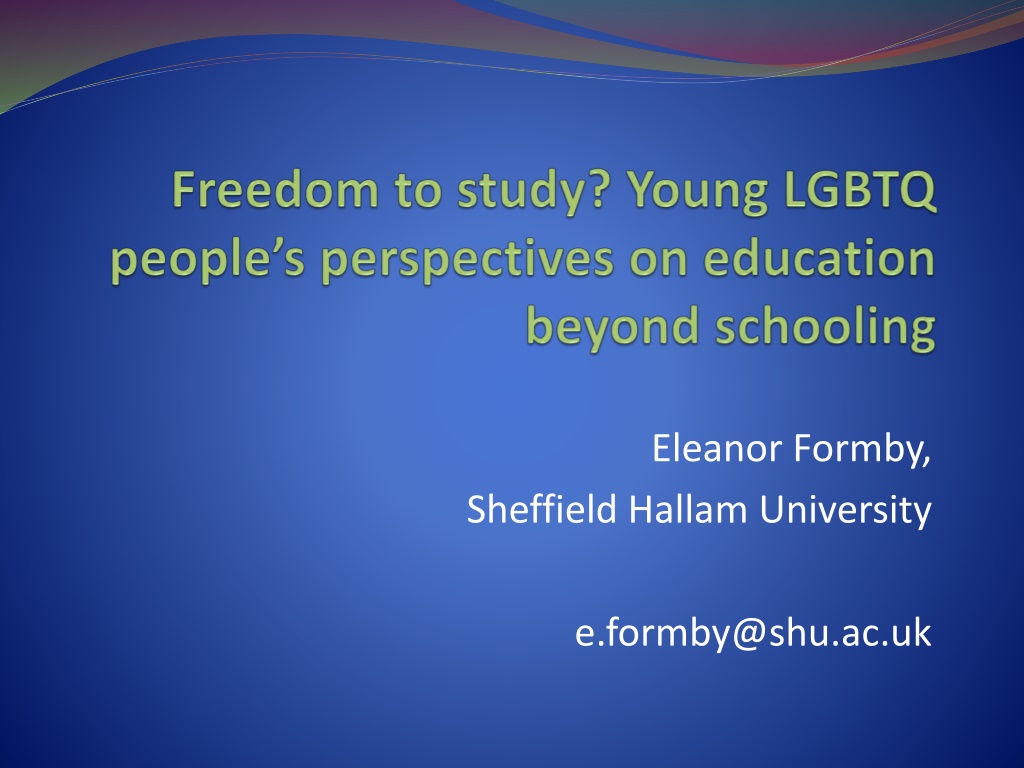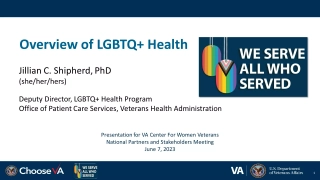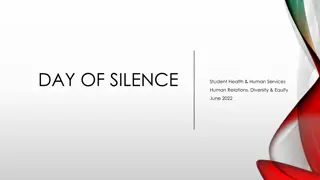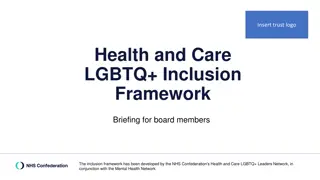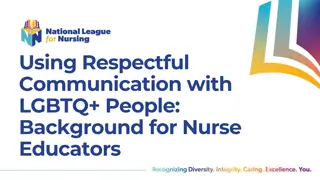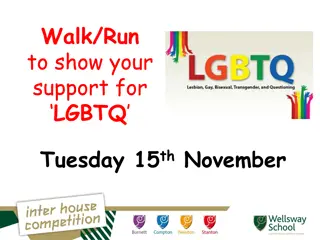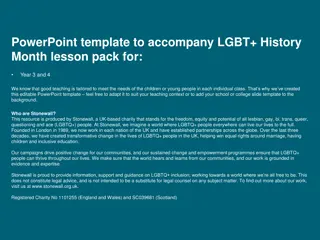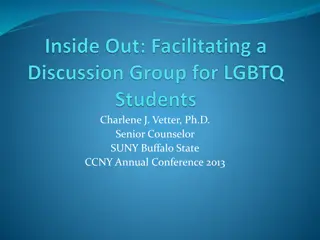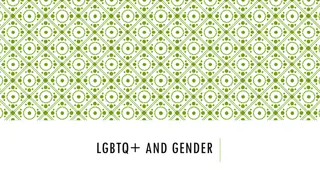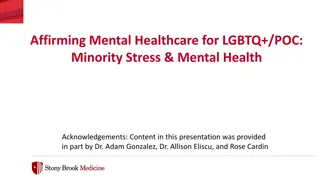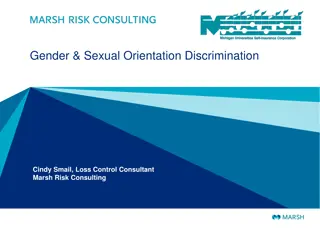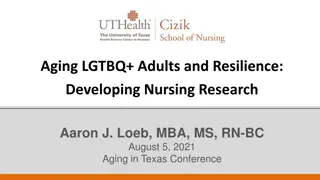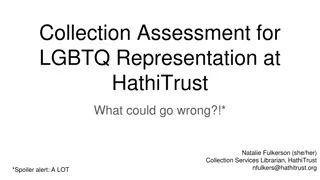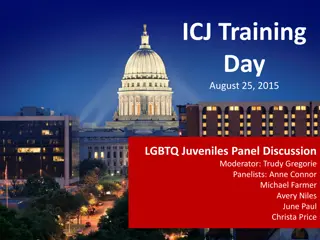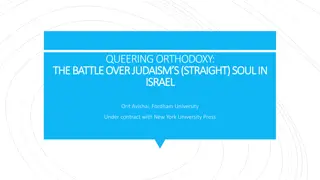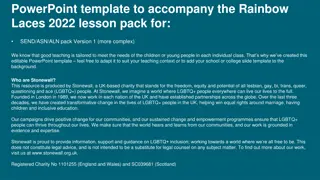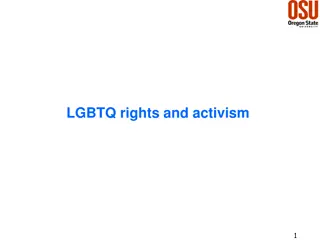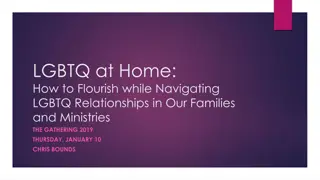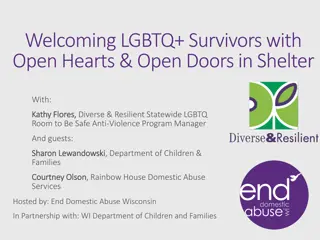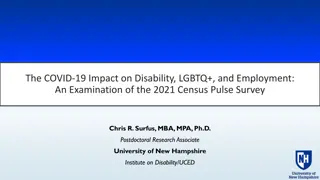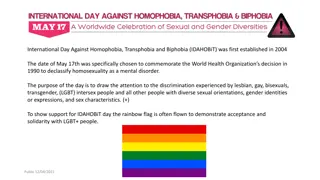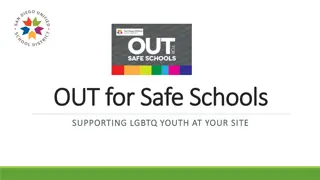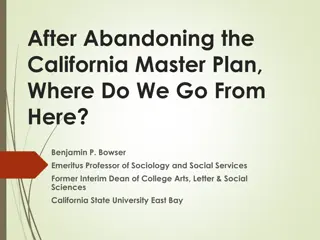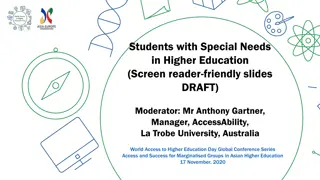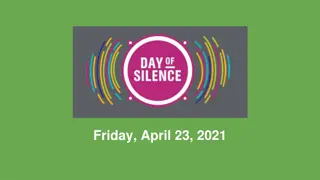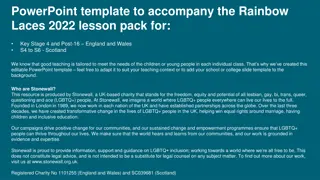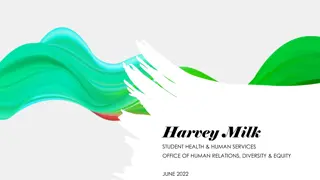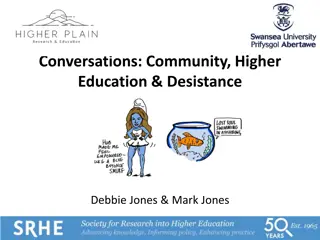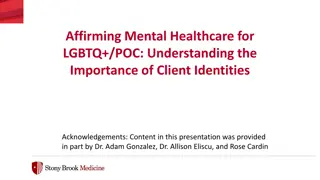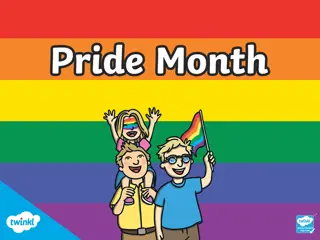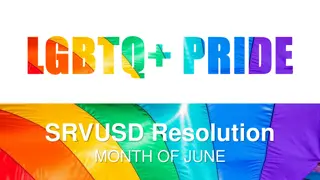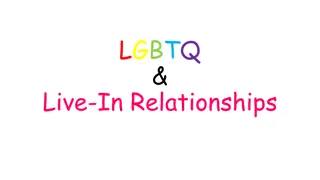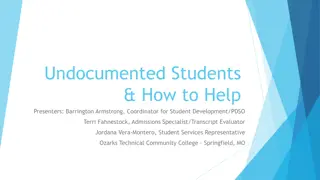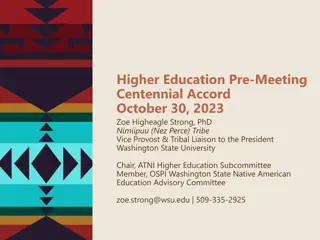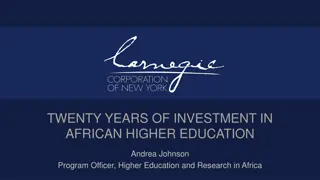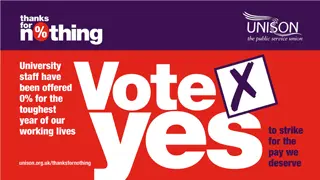Exploring Challenges Faced by LGBTQ+ Students in Higher Education
This research presentation by Eleanor Formby from Sheffield Hallam University delves into the existing literature on LGBTQ+ young people in higher education, highlighting themes of discrimination, prejudice, financial issues, and more. The findings reveal concerning levels of harassment, fear of losing financial support, and lack of safety on campus for LGBTQ+ students. Practical implications and evidence gaps are discussed, emphasizing the need for further research and support in this area.
Download Presentation

Please find below an Image/Link to download the presentation.
The content on the website is provided AS IS for your information and personal use only. It may not be sold, licensed, or shared on other websites without obtaining consent from the author. Download presentation by click this link. If you encounter any issues during the download, it is possible that the publisher has removed the file from their server.
E N D
Presentation Transcript
Eleanor Formby, Sheffield Hallam University e.formby@shu.ac.uk
Presentation outline Existing literature themes European research Conclusions / key messages Practice implications Remaining evidence gaps #FreshersToFinals ...more to come!
Existing literature Studies with/about LGBTQ young people dominated by secondary school and/or bullying Higher education less often explored - more often in USA Themes: - discrimination, prejudice and bullying - financial issues - housing issues - facilities and service provision - curriculum and course content - careers related issues - geography
Discrimination, prejudice and bullying Ellis (2009: 733): 23% of students experienced homophobic harassment/discrimination at least once 54% of respondents deliberately concealed their sexual or gender identity LGBT students do not particularly perceive a climate of fear , but actively behave in ways that respond to such a climate ECU (Valentine et al, 2009): 47% of LGB students received HBT comments from students; 9% from teaching staff 43% of trans students received HBT comments from students; 19% from staff Over 60% not out to teaching staff
Discrimination, prejudice and bullying (2) Keenan (2014): language use banter , but othering ... (see also Taulke-Johnson, 2010a) NUS (2014): only 21% of trans students felt completely safe on campus (37% of LGB students did) 1 in 5 LGB and 1 in 3 trans respondents experienced at least one form of bullying or harassment on campus levels of reporting low (including of physical assault)
Financial issues ECU (Valentine et al, 2009): both fear of losing financial support from families (amongst 15% and 35% of LGB and trans students respectively), and actual loss of financial support (amongst 5% and 7% of LGB and trans students respectively) further 3% of LGB students and 9% of trans students estranged from parents so do not receive financial (or other) support NUS (2011): LGB students less likely to receive information on financial entitlements from family members than heterosexual students and less likely to receive financial support or help from families LGB students more likely to be in debt, and in higher amounts
Accommodation issues (UK) ECU (Valentine et al, 2009): homophobic abuse in university accommodation, and inappropriate responses desire for gay-friendly housing, and safe / inclusive spaces within (non-specialist) accommodation specific concerns for trans students (see also Beemyn, 2005; Pomerantz, 2010) Taulke-Johnson (2010a: 402) on gay men: intolerant, unwelcoming, hostile and homophobic vandalism used to permanently brand participant s doors with anti-gay sentiments some voluntarily transferred accommodation, others modified their behaviour to prevent visible presence of gayness
Accommodation issues (US) Evans and Broido (2002) on lesbian and bisexual women: direct and indirect harassment and lack of support from roommates and other residents Krum et al (2013): apartment-style housing and self- contained singles preferred options for transgender and gender non-conforming people considering living on campus Seelman (2014): trans women are at greater risk than gender non-conforming people for being denied access to housing and bathrooms
Facilities and service provision NUS (2014): trans students reported main difficulties on campus as lack of gender-neutral toilets and facilities; lack of policies to support updating name and gender on student register; issues related to university security services; prevalence of transphobia (see also Beemyn, 2005) being repeatedly misnamed and/or misgendered represents serious barrier to inclusion (see also Formby, 2014a) campus LGBT societies/groups may have impact on LGBT students experiences of HE... 28% of LGB students and 42% of trans students were members of their LGBT society 45% of LGB and 52% of trans respondents were aware of the society before applying
...impact on choice-making ECU (Valentine et al, 2009): identities had been a factor in choice-making for 15% of LGB and 24% of trans students positive images of LGBT people in university brochures, prospectuses, websites had influenced students decisions Kane (2013): existence of LGBT student organisation used as key indicator of safer campus - influences student decision-making about university (see also Epstein et al, 2003)
Curriculum / course content Ellis (2009): LGBT issues inadequately represented in the curriculum minority of respondents felt comfortable raising these issues in class NUS (2014): I see LGB experiences and history reflected in my curriculum - 3.9 (out of 10) I see trans experiences and history reflected in my curriculum - 2.5 (out of 10) ECU (Valentine et al, 2009): statistically significant relationships between experiences of homophobic/biphobic comments and disciplines - esp. medicine and dentistry, veterinary science, agriculture and related, engineering, business and administration studies, European languages, literature and related, education
Careers related issues Nauta et al, 2001: non-heterosexual students experienced less support and guidance Schneider and Dimito, 2010: those who had experienced anti- LGBT discrimination in the past were most likely to report their identity influencing academic/career choices - both positively and negatively Schmidt et al, 2011: perceived discrimination contributes to vocational indecision Scott et al, 2011: transgender students face unique challenges that many university careers advisors are not equipped to handle Tomlinson and Fassinger, 2003: lesbian students perceptions of campus climate are important in predicting their career development - positive perceptions appear to enhance vocational advancement
Geography Taulke-Johnson (2010b): moving towards gay-friendly and accepting moving away from intolerant and repressive Epstein et al (2003): participants wanted to move to universities with large gay scenes nearby - thought to be more tolerant / supportive Pull and push factors echo broader research on LGBT migration (Formby, 2012) Commercial scenes draw people to urban locations and influence university choice-making (Taulke-Johnson, 2010b; Valentine et al, 2009) ECU (Valentine et al, 2009): smaller rural campuses may offer more protection ?
Impact? NUS (2014): 1 in 10 trans students never felt comfortable to speak up in class LGBT students who were out to teaching staff tended to feel more confident to speak up in class (89%) than those who were only out to friends (79%) LGB students more likely to consider dropping out than heterosexual students 56% of LGB students cited not fitting in as the main reason for considering dropping out 51% of trans respondents had seriously considered dropping out LGBT students who had experienced homophobic or transphobic harassment were 2-3 times more likely to consider leaving 1 in 7 trans respondents interrupted their studies related to their transition ECU (Valentine et al, 2009): 20% of LGB students had taken time out of their course related to their sexuality, homophobic discrimination, bullying 29% of trans students had taken time out due to trans-related issues, transphobic bullying, harassment
Complexity! HOWEVER... NUS (2014) LGBT students overall had a positive view of higher education - safer space than the rest of society? ECU (Valentine et al, 2009): majority of students said their institution had enabled them to be themselves by coming out Higher education levels can be erroneously conflated with tolerance (Taulke-Johnson, 2010a, b) Events which can be read as homophobic... can actually be framed, experienced and made sense as not (Taulke-Johnson, 2008: 128; see also Formby, 2013) Wider society feared? (Formby, 2012)
IGLYO research Funded by the international LGBTQ youth and student organisation - IGLYO (Formby, 2014b) Focused on the impact of homophobic and transphobic bullying or discrimination on continuing in education and/or pursuing employment - shift away from mental health and emotional wellbeing Self-completion survey (open and closed questions): 187 responses from Belgium, Bosnia and Herzegovina, Croatia, Denmark, Finland, France, Germany, Iceland, the Republic of Ireland, Italy, Lithuania, Malta, the Netherlands, Norway, Poland, Spain, Turkey, and the UK
The participants Self-identified young people: age range 15-38; mean average 25 40% identified as gay (male or female), 18% as lesbian, 11% bisexual, 7% queer, 3% unsure or questioning, 1% heterosexual, 2% none of these 44% identified as male, 29% as female, 5% genderqueer, 1% gender variant, 1% trans, 1% none of these 6% had at some point identified as trans 44% were involved in full time education, 23% in part time employment, 17% part time education, 16% full time employment, 5% on another course or apprenticeship, 4% NEET (not in education, employment or training) 37% had high school qualifications, 27% undergraduate university degrees, 25% postgraduate or doctoral degrees
School experiences Over half had been outed as LGB Over three quarters had experienced rumours or gossip about them Just under three quarters experienced name calling Just under half experienced threats or intimidation Over a quarter experienced physical assault Influenced peer relationships, and school work... Around half said they struggled to concentrate, did not feel motivated, and chose not to participate in class 40% felt they did not acquire skills at school as well as they should have done, and 37% thought they achieved lower marks
More complexity! HOWEVER... I actually think it helped to improve my grades for the most part as I wanted to get out of school and into college as fast as possible [It] caused me to retaliate with an I ll show them attitude, causing me to aim higher
Aspirations and plans for the future Majority did not think their education (88%) or career (74%) aspirations had been restricted Over a third (37%) thought their experiences had influenced their choice of job or career (e.g. what job, which location), and (29%) choice of studies (e.g. what course, which institution) I think it affected me in a positive way because I chose to study to become a teacher, because I want to have the opportunity to talk about homophobia and bullying I feared working in caring roles because I feared what people would say if they found out I was gay and working with vulnerable people
Influences on choice of studies, career and/or geographical home I worry if it will be a safe space for me. I worry about repeat experiences similar to school. I worry about being able to participate as fully as I want to Given that university/further education is a completely different environment the challenge is convincing people that things are different. Many people think that it will be more of the same... [but] the truth is there are entire communities within college and most are accepting of LGBT people Lots of locations are not suitable for young gay people to attend further or higher education - I have limited myself to one or two locations based on this Universities are located in bigger cities, which allows LGBTQ students from small villages and towns to move and live their sexuality more openly
Experiences of post-school studying For 63% university/higher education had not been affected by any bullying, discrimination or fears (for 29% it had) 91% had felt left out or isolated at some point 69% had struggled to concentrate, 67% did not always feel motivated 62% chose not to participate in class questions or discussions 57% thought they had achieved lower marks for their work 55% did not feel they acquired skills as well as they should have done 49% had missed classes more than once 24% had changed university or institution 6% had dropped out of university as a result of their experiences
...and responses University counsellors just seemed to be trained to nod unhelpfully. No specialist training in gender or sexuality. It was a ridiculous waste of time Links with other research with LGBT youth that suggests therapeutic responses are often suggested by educational institutions, but not always experienced as helpful by young people (Formby, 2013; Formby, 2014a) I generally saw and heard derogatory remarks and situations that others were in. This motivated me to restart the LGBT society in my university and try my best to show that different sexualities and gender norms were OK
Moving on/in to employment 19% felt their ability to gain employment had been affected by prior experiences of bullying or discrimination 17% felt their CV was not as good as other people s 13% said having fewer or lower qualifications had affected the range or level of jobs they could apply for There are things I am too afraid to put on my CV, such as... my activities with my university s LGBT society
Continuum of experiences... From freeing At one end: university could be described as a positive experience that facilitates greater freedom within a more welcoming / inclusive environment than school... I think higher education is much, much more accessible and a better place for LGBTQ students. For me as a gay man I found it very open and encouraging and friendly The commonest strategy of resilience spoken of by our research participants was finding safe places and safe people... Some of the LGBT students spoke of their escape to university [in this way] (Scourfield et al, 2008: 332; See also Taulke-Johnson, 2008)
...To unsafe At the other end: not a place of safety or freedom... As an LGBTQ person I ve experienced more depression and less friendship and I spent huge amounts of time sorting out myself and my emotions than I would have done otherwise. This made it harder for me to choose the right course, and may make me drop out of university Probably the scariest thing that happened in the first year of uni (McDermott et al, 2008: 883) Higher education place to escape to, and context/incidents that people need to escape from Differing lived experience: different individuals, different courses, different universities, different cultures, different locations Need for nuanced understanding beyond bullying (Formby, 2013)
Conclusions and key messages Negative experiences of, or in, higher education can have specific impacts on young LGBTQ people s education and employment opportunities Impacts include loss of confidence, isolation, attendance and/or participation issues, and lack of motivation or concentration, resulting in potential academic attainment and achievement disadvantage Identifying as LGBTQ can impact upon a person s plans or aspirations for the future, regarding choice of studies or career, as well as migration decisions Migration issues apparent in people s desires to avoid certain areas for education and employment, and in people s desire to move to locations with more progressive legislative frameworks in which to live their lives Caution is needed to not portray LGBTQ people as inherent victims , as not all experiences were negative, meaning a one size fits all approach from professionals may not be helpful
Practice implications 1. An inclusive campus and curriculum with visible diversity, including LGBTQ identities and histories, throughout (which may necessitate training and information for staff) 2. Available advice, information and support (including careers-related) that is inclusive and useful to LGBTQ students, but which does not assume victimhood 3. Facilitation and support for student-led peer organisation and activities, for example via the NUS and institution LGBT society or groups A great majority of LGBT respondents would like to see LGBT perspectives and authors more systematically included in the curriculum where this is possible. This would create a greater sense of belonging for LGBT students and show universities commitment to equality and diversity. Furthermore, a more sensitive attitude from academic staff towards sexual orientation and gender identity would help LGBT students to feel more included in the classroom. Heterosexuality should not be assumed, and teachers should try to diversify more their examples and exercises to take into account everyone s perspective (NUS, 2014: 47)
NUS (2014) recommendations for institutions Create clear procedures to address homophobia and transphobia, and establish a point of contact on campus so students can easily report acts of bullying committed against them or someone they know Include LGBT issues and anti-bullying policies during inductions, particularly in halls of residence Improve access to information and services, specifically health services on campus, and improve information on sexual health for every sexuality Have gender-neutral toilets and facilities to enable everyone use them safely and without fear of being outed or misgendered Facilitate changes of name and gender on student registers and preserve students confidentiality in doing so Train staff on LGBT issues and include respect for students identity in the university code of conduct to avoid situations where students are misnamed or misgendered Include LGBT perspectives and authors in curricula and raise students awareness on equality and diversity issues to prevent ignorant or offensive comments in social or teaching spaces Include LGBT provision and positive LGBT content in prospect, introducing your LGBT society to all students (see also Beemyn, 2003; Beemyn, 2005; Beemyn et al, 2005a, b; Consortium of Higher Education LGBT Resource Professionals, 2014; Gortmaker and Brown, 2006)
Remaining evidence gaps? Marked absence of literature on further education (NUS, 2014) Research that looks at the experiences of older LGBTQ students NUS (2014) identified need for more research on/in students halls Some evidence that bisexual students may have particularly poor experiences - need to investigate further (Klein and Dudley, 2014; NUS, 2014) NUS (2014) pointed to need for further exploration of the impact of LGBT youth homelessness on education and employment More detailed understanding of the impact and experiences of LGBT groups/societies on campus, and role in university decision-making More research in the UK with trans and non-gender binary identifying students/potential students
The #FreshersToFinals project Watch out for... - fuller literature review - final report and guidance document produced in consultation with LGBTQ young people and students - future events (LGF, Manchester; SHU, Sheffield)
